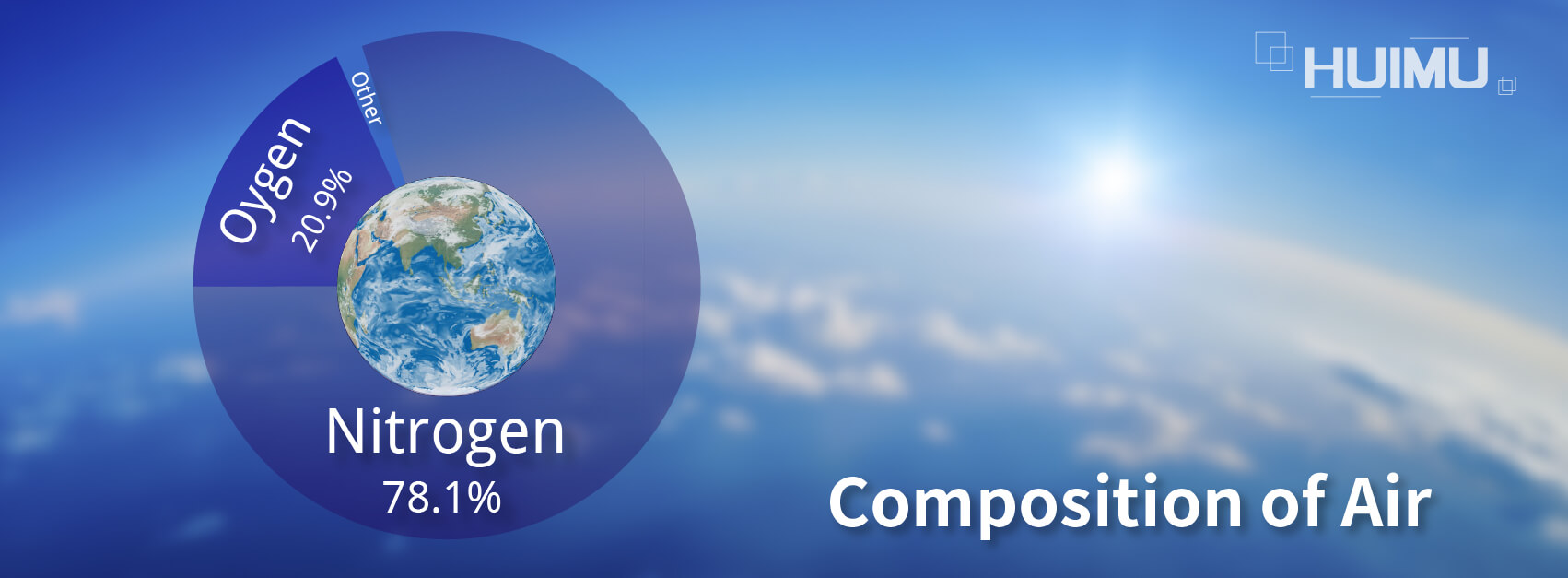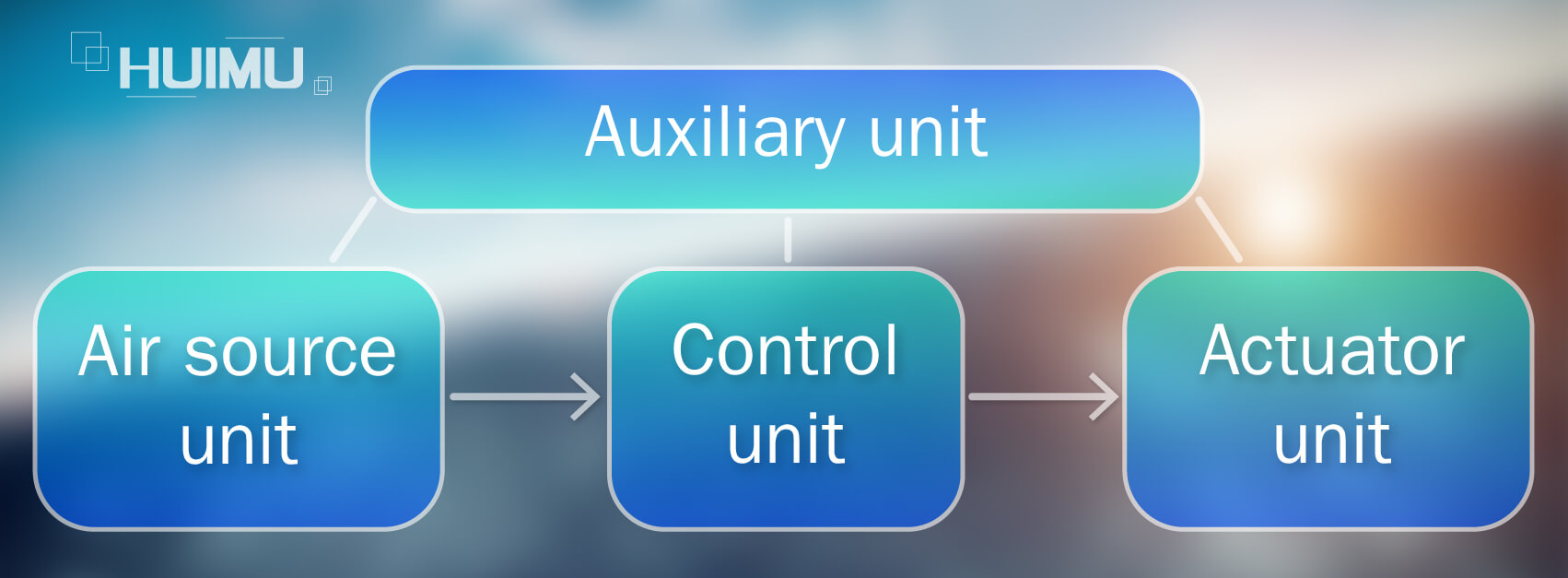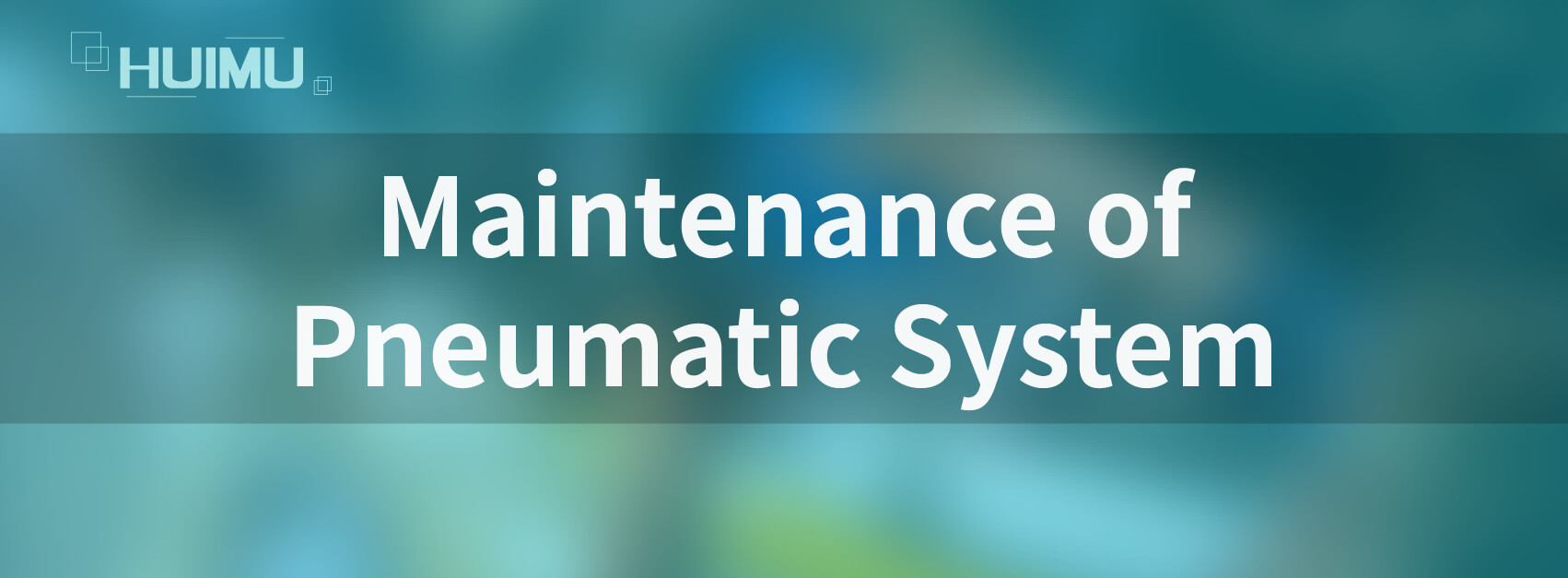
What is the Pneumatic System?
With the development of science and technology, pneumatic systems have increasingly become an integral part of today's automation field. This article will briefly introduce the definition, composition, application and maintenance of pneumatic systems. Click on "What are the Basic Pneumatic Components?" for a brief introduction to basic pneumatic components. Click on "What are the differences between Hydraulic System and Pneumatic System?" to learn about the differences between pneumatic and hydraulic systems.
You can quickly navigate to the chapters you are interested in through the Directory below, and the Quick Navigator on the right side of the browser.
CONTENTS
§1. What is the Pneumatic System? |
§2. What is the Construction of Pneumatic System? |
§3. What is the Application of Pneumatic System? |
§4. How to Maintenance the Pneumatic System? |
§1. What is the Pneumatic System?
1.1 Introduction of Pneumatic System

Pneumatic systems are industrial systems that use gas as a power source and working medium. The pneumatic system draws air from the atmosphere through an air compressor and stores it in a storage tank. By compressing the volume of air, the pressure of the compressed air is increased. Under the control of a control valve, the compressed air is delivered to the corresponding actuator via a pneumatic hose. And pneumatic actuators use this compressed air to generate mechanical movements to perform the specified task. Pneumatic systems have gradually become an integral part of industrial automation, especially when pneumatic systems are combined with electronic control systems.
1.2 Features of Pneumatic System
Pneumatic system uses clean and dry air as the power source, which is very environmentally friendly and safe. Pneumatic systems are well suited to work in harsh manufacturing environments compared to those industrial systems that use electric motors or internal combustion engines as the power source. Pneumatic systems, in conjunction with electronic control systems, are capable of very efficient motion and can perform repeatable mechanical operations. However, in contrast to electronic systems, pneumatic systems cannot perform high frequency repetitive operations. The pressure and volume of compressed air can affect the efficiency of a pneumatic system, and if changing the ambient temperature makes the air expand and contract, then the accuracy of the pneumatic system's work can be affected. In mobile equipment field, since hydraulic or electromechanical systems are usually bulky and require sufficient electricity to provide a power source, they are not suitable for mobile equipment, while lightweight and simple pneumatic systems are often used in mobile equipment. In portable robots, it can provide automatic control with a simple electrical control system and a compact pneumatic system. For workers, an air gun can be used for installing and fixing work, as long as to ensure that the pressure of compressed air is sufficient, even in the case of power failure can also carry out normal operations. Generally speaking, pneumatic systems have the advantages of high adaptability, high reliability, high portability and low price.
§2. What is the Construction of Pneumatic System?
2.1 Pneumatic Working Medium

The working medium of pneumatic systems is usually compressed air, which can be supplied continuously because it is taken directly from the free air in the atmosphere. In addition to compressed air, other gaseous media such as oxygen-free nitrogen (OFN), carbon dioxide (CO2) and other inert gases may be used in stand-alone pneumatic systems (e.g., portable pneumatic tools, small vehicles, robots, etc.). These inert gases make up a high percentage in the atmosphere, such as nitrogen (N2) at about 78.1% and carbon dioxide (CO2) at about 0.04%. Inert gases are relatively easy to obtain, but they are much more expensive to obtain and store than the free air. The properties of inert gases are different from those of the free air, such as carbon dioxide liquefies when pressurized, therefore, by liquefying the carbon dioxide, more carbon dioxide can be filled in a limited container. So compressed carbon dioxide is commonly used in portable pneumatic systems. Inert gases do not cause fires because they do not produce oxidation reactions, but leaks of inert gases can cause asphyxiation and freezing hazards. It is important to note that although oxygen (O2) is a high percentage of the atmosphere at about 20.9% and the leakage of oxygen is not asphyxiating, oxygen can cause fires, so compressed oxygen should not be used as a gas medium for pneumatic systems. Therefore, in most cases, compressed air is used as the preferred choice for pneumatic systems because it is readily available, free of charge, and will not cause asphyxiation or fire even if it leaks. In order to maintain the efficient operation of the pneumatic system and the proper functioning of the various pneumatic components, the air source itself must be constantly filtered and monitored, which also helps to ensure the long-term life of the pneumatic system. Water, oil, solid particles, etc. in compressed air need to be filtered out to prevent corrosion of pneumatic pipes and failure of pneumatic components. And with the adequate amount of atomized lubricant in the compressed air, the mechanical parts can work better.
2.2 Pneumatic Transmission System

The pneumatic transmission system consists of the air source unit, the actuator unit, the control unit and the auxiliary unit. The air source unit is capable of converting the mechanical energy provided by the air compressor into the pressure energy of compressed air and storing the compressed air in the storage tank. The air source unit also contains ancillary equipment such as air source purification devices. The actuator unit converts the pressure energy of compressed air into mechanical energy of the pneumatic actuator. Pneumatic actuators include cylinders (linear reciprocating motion), oscillating cylinders (oscillating motion), pneumatic motors (rotary motion), vacuum suction cups (vacuum pressure as the power source) and etc. The air pressure of the compressed air in a pneumatic system is at about 100 psi or less, so the output power of the pneumatic system is low, and the size of the pneumatic actuator is relatively small. If you want to increase the output capacity of the pneumatic system, you need to increase the size of the pneumatic actuator or equip the pneumatic actuator with a small hydraulic cylinder to form a pneumatic-hydraulic booster. The control unit is used to control and regulate the pressure, flow rate and flow direction of compressed air and can be divided into pressure devices, flow devices, direction devices and logic devices according to their functions. The control unit enables the pneumatic actuator to be able to work according to the required function and performance. The auxiliary unit includes oil misters, mufflers, tubing and fittings, converters, displays, sensors, etc., and they are used to lubricate the interior of the pneumatic system, reduce the exhaust noise of the pneumatic system, connect each pneumatic components, and process the pneumatic signals (such as conversion, display, amplification, detection), etc.
2.3 Pneumatic Logic System
In recent years, pneumatic logic systems have begun to gradually replace pneumatic control devices due to the decreasing size and cost of digital control components and the increasing accuracy and functionality of its performance. Pneumatic logic systems include the "and" unit, the "or" unit, relays, booster devices, latches, timers, fluid amplifiers, etc. Although pneumatic logic systems are reliable and powerful for automatic control, pneumatic control devices are still the dominant method today due to upgrade costs or safety concerns.
2.4 Pneumatic Servo System
The composition of pneumatic servo system is no different from that of hydraulic servo system, but due to the compressibility of gas, the servo stiffness of pneumatic servo system is usually much lower than that of hydraulic servo system. The traditional pneumatic system can only be reliably positioned at two points, and its movement speed can only be individually adjusted by a one-way throttle, which can not meet the current needs of automatic control. However, the pneumatic servo positioning system can be very convenient to achieve continuous positioning of multi-point and flexible positioning of any position. And because the movement speed of piston servo cylinder is continuously adjustable, it replaces the traditional throttle valve and cylinder cushioning method, so it can achieve the best speed and buffer effect, and significantly reduce the cylinder action time, shorten the process beat and improve productivity. Due to the advantages of simple structure, stable and reliable performance, good fire and explosion-proof performance, pneumatic servo system is widely used in metallurgy, gas, petrochemical, flight control and other fields.
§3. What is the Application of Pneumatic System?

Pneumatic systems are widely used in modern industries such as automated manufacturing, food and medicine, dentistry, construction, mining, and robotics. The functions of pneumatic systems are mainly divided into control, processing, packaging, handling, etc.
3.1 Controlling
Since pneumatic systems do not generate electrical fires, they are very suitable for flammable and explosive working environments. In the oil, mining, and chemical industries, any spark can cause irreparable disaster, so pneumatic systems are widely used to control their automated pipeline system. Pneumatic systems are also widely used to actuate large valves in chemical plants and refineries. Pneumatic systems are also used to control air brakes in vehicles, door openers and closers, HVAC control systems, guidance devices in aircraft, etc.
3.2 Processing
Since compressed air can act as a cushion, pneumatic systems can often provide gentler mechanical energy than that of hydraulic or electromechanical systems, therefore, pneumatic systems are widely used in automated production, such as the insertion and soldering of electronic components, and the assembly of household appliances. Electronic control systems make up for the lack of positioning accuracy of pneumatic systems, making them comparable to hydraulic or electromechanical technologies. The electronic control system also provides the pneumatic actuator with controlled press or squeeze capability and to perform rapid and repetitive mechanical movements. In CNC machine tools, pneumatic systems are able to control the automatic clamping and unclamping of tools, the automatic loading and unloading processes of machined parts, the rewind action of tool magazines, the air cooling of machined parts and the cleaning of fixtures, the automatic clamping and unclamping of attachment milling head tools, etc. In machine installation and maintenance, pneumatic actuators (e.g. pneumatic manipulators, pneumatic nail guns, pneumatic wrenches) can provide reliable assistance to operators.
3.3 Packaging
Since pneumatic systems are very safe and environmentally friendly and do not consume any components in the air or emit any harmful substances during the working process, they are widely used in medical and food processing equipment, such as the canning of wine, oil and gas, and the packaging of various food and medicine products.
3.4 Handling
Since pneumatic systems can convert the energy of compressed air into linear or rotary motion, they can be used to perform "pick and place" tasks. Industrial robots with pneumatic systems can replace human wrists, hands and fingers and can correctly and quickly perform subtle movements like gripping and releasing, such as fixing, positioning, clamping and transporting parts. In automated production lines, vacuum robotic arms are capable of lifting both heavy car bodies and moving precision silicon wafers. In document delivery systems, pneumatic devices can lift, press, sort or stack mail.
§4. How to Maintenance the Pneumatic System?

The service life of pneumatic systems is usually long and almost maintenance-free, but only if the necessary air source treatment and testing work is done.
4.1 Air Source Treatment
Since compressed air is the working medium and the power source of the pneumatic system, the quality and performance of the compressed air will affect the service life and efficiency of the pneumatic system. Before compressed air can be involved in the work, its air source must be treated. Water vapor in compressed air must be filtered to ensure that the compressed air is dry, otherwise this water vapor will condense in the pneumatic system, affecting the normal work of the pneumatic actuators, and corrode the pipes, valves, cylinders, etc. Solid particles such as dust in the compressed air also need to be filtered, otherwise it will cause the valve body action to fail. By installing a suitable filter, the solid impurities in the air can be effectively filtered out to ensure the cleanliness of the compressed air in order to reduce the wear and tear of the pneumatic actuators and extend their service life. Oily substances in the compressed air also need to be filtered, otherwise they can cause deterioration of rubber, plastic and sealing materials. The quality of the filtered compressed air is monitored in real time by the air source detection device through sensors to ensure the efficient operation of the pneumatic system and the proper functioning of the pneumatic equipment. It should be noted that the compressed air discharged from the air compressor contains compressor oil particles (particle size 0.01-0.08 μm), which oxidize rapidly at the exhaust temperature (120-220ºC) into a dark, sticky sludge that adheres to the spool of the reversing valve and reduces its sensitivity. By installing an oil mist separator after the filter of the pneumatic system, such oil particles below the μm level can be filtered out to avoid reducing the sensitivity of the reversing valve, and the sensitivity of the reversing valve can also be ensured by regular cleaning of the reversing valve.
4.2 Air Pressure Testing
The air supply pressure affects the efficiency of the pneumatic system, so it is necessary to ensure that the pneumatic device has the right working pressure and movement speed. When adjusting the working pressure of the pneumatic device, you should make sure that the pressure gauge readings are accurate, as well as working reliably. In addition to this, the pneumatic system needs to be checked for air leakage, because air leakage will not only increase energy consumption, but also lead to a drop in air supply pressure, and even cause the pneumatic components to not work properly. There are many reasons for air leaks in pneumatic systems, but the main cause is ozone cracking of rubber components (such as pipes and seals) because ozone eats away at the rubber material causing it to age and crack. If the air leak is very serious, then when the pneumatic system stops working, an ear-piercing sound of air leak will be heard, and the leak should be sealed immediately or the corresponding components should be replaced. If the air leakage is very slight, it can be checked by applying soapy water, or using a test instrument.
4.3 Condensate Testing
Accumulated fluids should be removed promptly before the pneumatic system is operated, otherwise they will return to the compressed air. Normally, the filtered condensate can be drained to other places through the automatic drain. When the night temperature is below 0℃, in order to prevent the condensate from freezing, the drain valve should be opened in time to discharge the condensate when the pneumatic system stops running.
4.4 Lubricant Testing
Compared to hydraulic oil in hydraulic systems, compressed air in pneumatic systems does not have any lubricating ability by itself, so the right amount of lubricant needs to be added to the compressed air to ensure the working efficiency and service life of pneumatic actuators and air control devices.The lubricant in compressed air can reduce the frictional resistance of the cylinder and increase its thrust (with the development of technology, the cylinder with oil-free lubrication technology is becoming more and more popular), can ensure that the valve and other devices will not cause damage or action failure due to rust, and can also avoid the air leakage caused by the wear of the sealing material. The air lubricator can add appropriate amount of atomized lubricant to the compressed air, typically 1mL of lubricant per 10m3 of free air. The air lubricator is usually installed after the filter and pressure reducing valve. When replenishing the lubricant, you need to check the quality of the oil in the air lubricator and the amount of oil dripped to meet the requirements.
4.5 Pneumatic Components Testing
The inspection of pneumatic components helps to ensure the reliable work of the pneumatic system. For the pneumatic cylinder, it needs to detect whether there is air leakage between the piston rod and the end face; whether there is scratch or deformation on the piston rod, pipe joint, pipeline, etc.; whether there is abnormal sound when the cylinder moves; whether the buffer effect of the cylinder meets the requirements. For solenoid valve, it needs to detect whether the shell temperature of the solenoid valve is too high; whether the solenoid valve is normal action; whether the solenoid valve is air leakage (after the pneumatic cylinder stroke, check whether there is air leakage from the exhaust port of the solenoid valve); whether the fastening bolts and pipe joints of the solenoid valve are loose; whether the voltage of the solenoid valve is normal; whether the wire of the solenoid valve is damaged. For the air lubricator, it needs to detect whether the lubricant in the oil cup is sufficient; whether the lubricant is discolored and cloudy; whether there is dust and moisture deposited at the bottom of the oil cup; whether the amount of oil dripping is appropriate and whether the exhaust port is moistened by oil (a clean white paper can be placed near the exhaust port, if the oil mist spots are left on the white paper after the reversing valve is working for three to four cycles, it shows that the lubrication performance of compressed air is good). For the filter, you need to check whether condensate has accumulated in the water cup; whether the filter element needs to be cleaned or replaced; and whether the condensate drain valve operates reliably. For regulators, it needs to check that the pressure gauge reading is within the specified range; that the valve cover or nut is locked tight; and that there are no air leaks. For safety valves and pressure relays, it needs to detect whether the wires are damage; whether its operation is reliable at the regulated pressure; whether it is sealed or locked after its calibration is passed.

Get in touch with us now!
Please take a minute or two to complete this simple form to get reply in 24 hours, thank you!
*Please check the trash box of your mailbox, if you do not receive our email.



